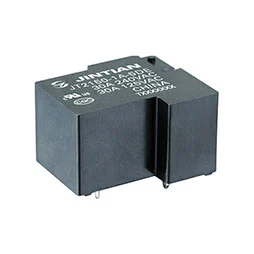
A miniature high power relay is an electromechanical switching device that can handle high levels of power while occupying a relatively small amount of space. They are designed for use in applications where high power switching is required but space is limited.

The operating principle of a miniature high power relay is based on the electromagnetic principle. It consists of a coil, an armature, and a set of contacts. When a current is passed through the coil, it creates a magnetic field that pulls the armature towards the coil, causing the contacts to close or open, depending on the relay type.
The coil is wound around a ferromagnetic core, which amplifies the magnetic field. The armature is a movable iron or steel component that is attracted towards the magnetic field created by the coil. When the armature moves, it either opens or closes the contacts, depending on the design of the relay.
The contacts are made of conductive material, such as silver, gold, or copper, and are designed to handle high power loads. When the contacts are closed, they allow the flow of current through the circuit, while when they are open, they interrupt the flow of current.
The operating principle of a miniature high power relay is reliable, efficient, and widely used in various applications that require the switching of high voltage and current loads.

Life cycle testing: The relay is subjected to a large number of cycles to test its durability and performance over time. This test ensures that the relay can withstand repeated switching operations.
Contact resistance testing: The resistance across the contacts is measured to ensure that it is within the acceptable range. High resistance can cause the contacts to overheat and fail.
Insulation resistance testing: The insulation resistance between the coil and the contacts is measured to ensure that it is sufficient to prevent electrical arcing and short circuits.
Dielectric strength testing: The relay is tested to ensure that it can withstand high voltage without breaking down. This test is performed by applying a high voltage between the coil and the contacts.
Environmental testing: The relay is tested under various environmental conditions, such as temperature, humidity, vibration, and shock, to ensure that it can operate reliably under harsh conditions.
Email:
lilian@zettlernb.comCall Us:
+86-574-62502203Address:
No. 5, Shuntai Road, Yangming Industrial Zone, Yuyao City, Zhejiang Province